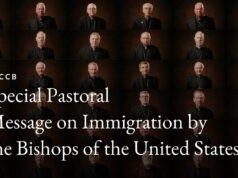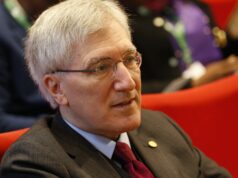
As the National Shrine of St. Elizabeth Ann Seton marked the 50th anniversary of the 1975 canonization of its namesake on Sept. 14, the Emmitsburg, Maryland, campus hosted what was dubbed “A Day of Joy” as part of a three-day celebration attracting over 3,000 visitors.
Lively music — from chamber, gospel and school choirs and choruses; country, worship, and contemporary singers; and a university band — continuously filled the air.
Dramatic monologues brought saints-to-be to life, while their canonization causes could be discovered at more than 20 information tables in the “Saints On Their Way Village.” Authors talked about their books, while children energetically played 19th-century games.
Baltimore Archbishop E. William Lori celebrated Mass in the basilica for 1,800 worshippers, and there were state-of-the art museum exhibits, expert lectures and tours of historic homes on the grounds where Mother Seton lived and worked from 1809 until her death in 1821.
And of course, there were tantalizing aromas from an array of food trucks.
What might Mother Seton, the first native-born American saint, make of all of it?
“Well, Elizabeth Ann Seton liked to have fun,” Rob Judge, the shrine’s executive director, told OSV News, speaking of the socialite-turned-sister’s early life. “We have two pairs of her dancing slippers in our collection. She loved to go to balls. So I think she’d be really happy. And I know she’s looking down on us from heaven.”
There’s a certain anachronistic charm to be found imagining the black-clad and bonnetted Mother Seton taking part in the day’s activities, enjoying herself just as much as anyone else. “Cheerfulness,” she advised, “prepares a glorious mind for all the noblest acts.”
Before Mass began, Msgr. Jacek Pinocy — representing Cardinal Christophe Pierre, papal nuncio to the U.S. — read a message expressing Pope Leo XIV’s good wishes.
“His Holiness prays that you will take encouragement from the Saint’s particular love of the Eucharist,” Msgr. Pinocy said, “and thus be drawn ever more deeply into a loving relationship with Jesus, Our Savior.”

In his homily, Archbishop Lori reminded the faithful that St. Elizabeth Ann Seton’s canonization anniversary coincides with the feast of the Exaltation of the Holy Cross, noting she “exalted the Cross by her life in all its amazing iterations.”
Her lifetime was punctuated by almost countless sufferings — including family deaths, setbacks and conflicts — to say nothing of the struggles of founding the first U.S. community for religious women and planting the seeds of Catholic education in America.
Nonetheless, “never angry with God, never bitter, she instead deepened her spiritual quest,” said Archbishop Lori.
“No matter what your vocation, no matter the highways and byways of your life, chances are that St. Elizabeth Ann Seton walked the same road,” Archbishop Lori concluded. “From eternity she reaches out to show us that true holiness of life is attainable in every vocation, amid every responsibility, amid every trial and suffering.”
That same theme of spiritual persistence was vividly displayed in the “Saints On Their Way Village,” where visitors chatted with representatives from the guilds of those they hope will eventually be canonized.
Nearly 100 American men and women are currently being considered for sainthood.
Represented were the sainthood causes of Bishop Simon Bruté; Father Vincent Capodanno; Father Solanus Casey; Father Walter Ciszek; Dorothy Day; Mother Henriette Delille; Sister Miriam Teresa Demjanovich; Joseph Dutton; Mother Mary Lange; Father Michael McGivney; Charlene Richard; Father Stanley Rother; Father Aloysius Schwartz; Father Francis Xavier Seelos; Sister Blandina Segale; Archbishop Fulton Sheen; and Brother Leo Williams. Other guilds that couldn’t be present sent materials.
Servant of God Bishop Simon Bruté (1779-1839) was a friend of Mother Seton, known to her from 1811 until her death in 1821.

“He said that her motherhood, her vocation, made sense of his priesthood,” explained Paige Hochschild, associate professor and chair of the Department of Theology at Mount St. Mary’s University in Emmitsburg, where Bishop Bruté taught as a priest.
Consecrated the first bishop of Vincennes, Indiana, in 1835, he was truly a pioneer prelate. “A week after he was consecrated, he wanted to do a tour of the entire diocese,” said Hochschild, “which was basically Indiana, Illinois and a good part of Michigan.”
Servant of God Father Walter Ciszek (1904-1984) — a Polish-American Jesuit once described as having “a baseball bat in one hand and a rosary in the other” who routinely advised the faithful to “give God your lousy best” — spent 23 years of hard labor and abuse in Soviet prison camps before returning to the United States.
“I would call him the saint of the ordinary,” said John DeJak, executive director of the U.S. Conference of Catholic Bishops’ Secretariat of Catholic Education and co-compiler of “With God in America: The Spiritual Legacy of an Unlikely Jesuit” (Loyola Press).
“His message is one for every single Catholic — religious, lay, whatever — and it’s basically finding the will of God in your everyday life, and that the persons, places and things in your life at every moment are the will of God for you.”
“I think it’s actually a miracle that she still has her legacy continuing today,” said Sister Seyram Mary Adzokpa, a temporary professed member of the Sisters of the Holy Family, a Catholic religious order of African-American nuns founded in 1837 in New Orleans by Venerable Mother Henriette Delille (1813-1862).
Sister Seyram Mary noted a school, a nursing home, low-income housing projects and a day care in current operation. “I think that for her to be a saint is absolutely appropriate, because her legacy continues.”
Servant of God Joseph Dutton (1843-1931) fought in the American Civil War and afterward worked collecting the bodies of the dead for internment at a cemetery in Corinth, Mississippi. Perhaps it was this grim task that developed his compassion, but — after a failed marriage, a drinking problem and baptism into the Catholic Church at 40 — he decided his ministry was to the sick.
“He saw a story about Father Damien on the island of Molokai in a leper colony,” shared Lynn Paul Altadonna, a parishioner at Blessed Sacrament Church in Stowe, Vermont, the birthplace of Dutton. “He was asking for help. So he answered that call, found his way to the Hawaiian Islands and to Molokai, and told Father Damien, ‘I’m here to help you. What have you got to do?’ And he stayed there for the next 44 years.” St. Damien (Joseph de Veuster) was canonized in 2009.
Venerable Mother Mary Lange (1789-1882) founded the Oblate Sisters of Providence — the first African-American religious congregation in the United States — in 1829, well before such vocations were encouraged.
“The things that Mother Mary Lange had to go through — the rejection, the humiliation, all the things that people of color had to deal with — but still, she believed in the Lord,” said Phyllis Johnson, a lay associate for the Oblates and a member of the Mother Mary Lange Guild.
“She still wanted to help people. It didn’t matter,” Johnson added. “Because we’re all God’s children — and she knew that.”
Venerable Fulton J. Sheen (1895-1979) leveraged modern social communications platforms to spread the Gospel. His popular television program “Life is Worth Living,” peaked at 30 million weekly viewers.
His cause was stalled by a battle over relocation of his remains from New York City to Peoria, Illinois, and concerns that as bishop of Rochester, New York (1966-1969), the prelate might have overlooked sexual abuse by a former diocesan priest.
Allan J. Smith, founder and director of the Archbishop Fulton J. Sheen Mission Society of Canada, admitted waiting for Archbishop Sheen’s cause to advance can be frustrating. “We’re just waiting on a new date from Rome. I know that a lot of times people may say, ‘Should it have happened in 2014? Should it have happened in 2019?’ But it’s going to happen in God’s perfect timing.”
Judge was pleased with the many visitors to the “Saints On Their Way Village.”
“It’s just a beautiful example of the universal call to holiness,” he suggested. “No matter what your state in life, no matter what your circumstances are, everyone — through God’s grace — has the opportunity to get to heaven.”







